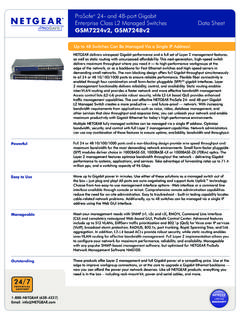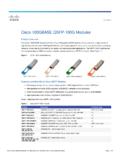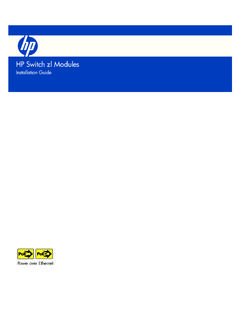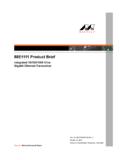Transcription of 10GBASE-T SFP+ Transceiver Module: Get the most out of ...
1 Technical White Paper: 10 GBASE-T SFP+ Transceiver module February 24, 2016. 10 GBASE-T SFP+ Transceiver module : get the most out of your Cat 6a Cabling Enabling More Cat 6a Connectivity for 10 GbE. Networking The world's most ubiquitous pluggable form-factor is now available as a 10 GBASE-T SFP+ Transceiver module giving Equipment designers and Data Center professionals a new option in architecting their network solutions. 1. Summary The SFP+ (enhanced small form factor pluggable) Transceiver , featured prominently in data center networks at 10Gb/s, is used in access or network edge equipment including: fabric extenders, access cards, top-of-rack (ToR) switches and leaf switches. Today the availability of a 10 GBASE-T SFP+. Transceiver module enables a new dimension of flexibility for the Network Equipment designer and for the Data Center professional looking to optimize capital expense and reduce recurring operational expense.
2 Introduction The last three years have seen the broad adoption of 10Gb/s connectivity at network edge equipment. Network access connectivity requires careful planning related to CAPEX and the subsequent implications for ongoing operating expense. While optical fiber dominates as the connectivity solution of choice in the core or spine due to high aggregated data bandwidth or where link lengths can be measured in hundreds of meter, Cat 6a unshielded twisted pair (UTP) cannot be beaten for cost, proven performance and ease of installation for network edge and 10Gb/s trunk lengths up to 100m. As reliable as the Cat 6a structured cabling ecosystem is, the relatively high power consumption of physical layer PHY silicon has motivated a variety of access connectivity solutions to proliferate in the marketplace that aren't interested in capitalizing on the benefits of Cat 6a UTP. The Evolving Data Center Network function virtualization (NFV), and unified data and storage networking have been broadly adopted today to migrate traditional, logical-only IT infrastructure to an abstracted virtual data center.
3 Virtualization enables asset consolidation. It also allows for increased machine utilization, 20% to 60% at a minimum, meaning less space is required with lower power and cooling costs. Virtualized resources can be rapidly scaled and provisioned to meet often unpredictable demands and allow enterprises to innovate and roll out new networking services to maintain a competitive edge. With improvements in utilization and virtualized assets, servers are now seeing increased I/O demands. To keep pace with the increased I/O demand, network access line rates have migrated from 1Gb/s to 10Gb/s. Several connectivity solutions exist to service these network access needs including direct-attach cables (DAC), optical Transceiver modules and embedded 10 GBASE-T RJ45 ports. Each come with its own set of distinct advantages and disadvantages but only one new solution offers the potential to deliver power saving connectivity utilizing Cat 6a cable infrastructure with pay-as-you-grow flexibility.
4 2. Network Access Connectivity Options SFP+ Direct Attach Cable Direct attach cables (DACs) have been available and deployed since about 2007. For 10Gb/s data rates, they are implemented as a fixed length of Twinax cable with SFP+ plugs integrated at both ends. Passive versions can be used for connections up to 7m and active versions for connectivity up to 15m. A DAC is a low power, low latency connection offering pay-as-you-grow flexibility but can be awkward, if not outright difficult to install through typical cable management. The degree of difficulty increases with DAC length. In addition to limited length, a DAC can be an expensive connectivity solution insomuch as it is does not take advantage of installed Cat 6a structured cabling. SFP+ Optical Transceiver module Short wavelength (850nm) optical Transceiver modules can be used for lengths up to 300m at 10Gb/s data rates. In comparison, multi-mode fiber cabling is considerably more expensive than Cat 6a UTP and the solution overall is not well suited for cost sensitive network edge applications.
5 Field termination of fiber requires special skill sets and tools which significantly increase the complexity and cost of installation. 10 GBASE-T RJ45. As feature size has reduced from 40nm to 28nm, the power consumption of 10 GBASE-T physical layer (PHY) devices has also decreased to approximately per port. This has led to the broad adoption of 10 GBASE-T being implemented as an embedded RJ45 port. The advantage of utilizing an embedded 10 GBASE-T RJ45 port is that it allows an organization to capitalize on their existing Cat 6a UTP structured cabling ecosystem. Nonetheless, a solution implemented with embedded 10 GBASE-T RJ45 ports lack flexibility. This risks underutilization meaning the initial capital outlay is an expensive proposition. Unused ports still consume power resulting in higher operating cost. 3. 10 GBASE-T SFP+ Transceiver module The new 10 GBASE-T SFP+ Transceiver module delivers the flexibility and port density well known to the SFP+ form-factor, utilizing Cat 6a UTP structured cabling for network connectivity.
6 It is a power optimized solution for lengths up to 30m, engineered to deliver a minimum power saving of at least per port compared to an equivalent embedded 10 GBASE-T RJ45 for the same length (Cat 6a, up to 30m). These power savings can add-up in ToR, mid-row and end-of-row switch connectivity. Implemented as an SFP+ form factor, the new 10 GBASE-T Transceiver module also delivers a pay-as-you-grow option. Why a 10 GBASE-T SFP+ Transceiver module ? There are several compelling reasons to consider a 10 GBASE-T copper SFP+ Transceiver module , both from a Network Equipment designer and Data Center architect/manager prospective: Reach: Up to 30m over CAT6a UTP cable, sufficient for all network access use cases Cost: Pay-as-you-grow model that performs for today and scales for tomorrow Reliability: The RJ45 connector interface is rock solid. No surprises when deployed in your data center Innovation: Hot pluggable with a managed soft-start Performance: Full PHY presentation, which means nothing is missing Smaller Footprint: Interoperable with any SFP+ cage and connector system 4.
7 The Network Equipment Designer The Data Center Professional New product design cycles are shorter than Maximizing asset utilization is critical in today's ever and getting shorter in order to keep pace data center. It's the catalyst for network with today's rapidly evolving network function virtualization. Under-utilized equipment demands. This can put a strain on resources, including idle I/O ports, consume limited design resources and product power which increase operating cost management. The availability of a 10 GBASE-T unnecessarily. With a virtualized environment, a SFP+ Transceiver module now allows the complete Enterprise Information System designer to partition the design at the MAC/PHY infrastructure can be deployed in less space boundary. All aspects of the physical layer PHY than in the past; however, the number of virtual implementation can then be handled with the servers in a given rack can easily quadruple the familiarity and ease of a MSA compliant SFP+ bandwidth requirements from earlier data port.
8 The electrical interface to the MAC runs center topologies. This need for increased edge- through the same 20-pin connector used for of-network bandwidth has motivated the any optical 10G SFP+ optical Transceiver proliferation of embedded 10 GBASE-T RJ45. module . From a printed circuit board layout ports. While much has been done to reduce the perspective, this saves considerable complexity, power consumption of the physical layer PHY, time and cost. Application resources are presently about per port, idle ports still available to assist with a broad range of consume power and incrementally nudge-up implementation questions that might come up operating expenses. The availability of a ranging from power supply rating to thermal 10 GBASE-T SFP+ Transceiver module allows management configurations. Also, ports deployment flexibility down to the individual designed for the 10 GBASE-T copper SFP+ can be 10G port, not previously possible with readily adapted to 10G SFP+ fiber Transceiver embedded 10G RJ45.
9 Additionally, the module modules. has been optimized to save more than per port when compared to an embedded The new 10 GBASE-T SFP+ Transceiver module 10 GBASE-T RJ45 port for link distances up to has the potential to make the Network 30m, with the potential for further operating Equipment designer's job much easier. cost savings. Network Edge equipment, developed with SFP+. ports and designed for the new 10 GBASE-T SFP+. Transceiver module , can be deployed to precisely match today's network edge bandwidth demand. It can also be migrated to a pay-as-you-grow model to meet future demand, optimizing initial capex and ongoing operating costs. 5. 10 GBASE-T SFP+ Transceiver module The DM7051 10 GBASE-T SFP+ copper Transceiver module is a feature-rich, high performance integrated duplex data link for bidirectional 10. Gigabit Ethernet communication over Cat 6a/7. cable. It's the first SFP+ Transceiver delivering 10.
10 Gb/s of communication for this type of media. The SFP+ module form factor has been with us since 2006 when the specification was first published. It's been adapted for every imaginable link type at 10 Gbs but only today is it available for the first time as a hot swappable 10 GBASE-T. module . Designers can now capitalize on the feature for host designs targeting network edge equipment where Cat 6a structured cabling dominates low cost. The data center professional also has the means to pay-as-you-grow all the Features way down to an individual 10G RJ45 copper port Supports Links up to 30m using Cat 6a/7. level if necessary, significant given the reach cable advantage of a 10 GBASE-T SFP+ Transceiver SFF-8431 MSA Compliant module over a DAC. The 10 GBASE-T SFP+. SFF-8432 MSA Compliant Transceiver module can reach to 30m over Cat 6a IEEE Compliant cabling, while a twinax DAC can only manage 7m.





